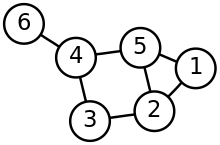What is meant by diameter of a network?
The diagram shown on this link of the \"A graph with 6 vertices and 7 edges where the vertex no 6 on the far-left is a leaf vertex or a pendant vertex.\" has DIAMETER 4
-
The Wikipedia Example
Looks like the diameter is 3 to me by definition.

The longest shortest paths have length of 3 edges, e.g. between
6-1and6-2.
The Mesh Example
Here's your second definition, with some typographical correction so that it makes sense:
Diameter
Dof a network is defined as the longest path of the shortest paths between any two nodes. For example, the diameter of a 4x4 mesh D = 6Let's take a look at the 4x4 mesh example:
A---B---C---D | | | | E---F---G---H | | | | I---J---K---L | | | | M---N---O---PThe longest shortest path has length of 6 edges, i.e. between
A-PandM-D.References
Mathworld - Wolfram/Graph Diameter
The length of the "longest shortest path" between any two graph vertices of a graph.
Graph and Digraph Glossary - cudenver.edu
Diameter: The diameter of a graph is the length of the longest chain you are forced to use to get from one vertex to another in that graph. You can find the diameter of a graph by finding the distance between every pair of vertices and taking the maximum of those distances.
See also
- Computing Distances and Diameter
- Has examples on weighted graphs
讨论(0)
- 热议问题

 加载中...
加载中...